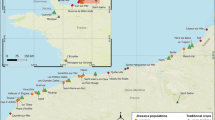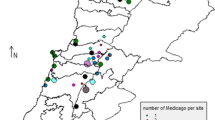Abstract
Perilla frutescens (L.) Britton is a traditional crop of East Asia and sporadically cultivated in different parts of the Himalayas. The Western and the Eastern Himalayan regions of India exhibit rich variability in oilseed Perilla, Perilla frutescens (L.) Britton var. frutescens. The present communication deals with the distribution pattern of diversity and survey, exploration and germplasm collection and its uses in India. Brief information on botanical characterization on the basis of systematic study of cultivated and weedy types and thrust on areas for germplasm collection from diverse habitats have been discussed.

Similar content being viewed by others
References
Arora RK (1997) Plant genetic resources of northeastern region: diversity, domestication trend, conservation and uses. Proc. Indian National Sci Acad B63 No.3:175–186
Arora RK, Pandey A (1996) Wild edible plants of India: diversity, conservation and use. National Bureau of Plant Genetic Resources, New Delhi, p 189
Arora RK, Sharm GD, Vandana J, Phogat BS, Bhatt KC, Rana JC (2006) Under-utilized crops. In: Dhillon BS, Saxena S, Agrawal A, Tyagi RK (eds) Plant genetic resources: foodgrain crops. Narosa Publishing House, New Delhi, pp 320–342
Atkinson ET (1982) Economic botany of the Himalayan region. Cosmo Publication, New Delhi, India, p 708
Babu CR (1977) Herbaceous flora of Dehradun, Council of Scientific and Industrial Research, New Delhi, pp 416–417
Cho JL, Choi YW, Kang H, Um SK (1986) Studies on germination of Perilla seeds (Perilla ocymoides L.) I. Effect of temperature and storage method on germinability (in Korean). Korean Soc Hort Sci 27:320–330
Collett H (1971) Flora Simlensis (rep. edn.). Bishan Singh and Mahendra Pal Singh, Dehradun, India, p 390
Duthie JF (1960) Flora of upper gangetic plains. 2 vols. (repr. edn.). Botanical Survey of India, Calcutta, India, p 122
Hanelt P, Institute of Plant Genetics and Crop Plant Research (eds) (2001) Mansfeld’s Encyclopedia of Agricultural and Horticultural Crops, vol 4. Springer-Verlag, Berlin, pp 1968–1970
Honda G, Koezaka Y, Tabata M (1994) Genetic studies of colour and hardness in P. frutescens. Jpn J Breed 40:469–474
Honda G, Yuba A, Kojima T, Tabata M (1996) Chemotaxonomic and cytogenetic studies on Perilla frutescens var. citrodora (Lemon Egoma). Nat Med 48:185–190
Hooker JD (1885) Flora of British India, vol IV. L.Reeve and Co., London, p 646
Jamieson GS (1943) Vegetable fats and oils. Reinhold, New York
Kanjilal UN, Das A, Kanjilal PC, De RN (1939) (reprinted 1982) Flora of Assam. Government of India, Shillong, vol III. pp 516–517
Kumar S (1999) The economic plants of northeast India. Scientific Publishers, Jodhpur, Rajasthan, India, p 46
Lee JK, Ohnishi O (2001) Geographic differences of morphological characters among Perilla crops and their weedy types in East Asia. Breed Sci 51:247–255
Lee JK, Nitta M, Kim N-S, Park CH, Yoon KM, Shin Y, Ohnishi O (2002) Genetic diversity of Perilla and related weedy types in Korea determined by AFLP analysis. Crop Sci 42:2161–2166
Li HL (1969) The vegetable of ancient China. Econ Bot 23:235–260
Maikhuri RK, Rao KS, Semwal RL (2001) Changing scenario of Himalayan agroecosystems: loss of agrobiodiversity, an indicator of envioronmental changes in central Himalaya, India. Environment 21:23–39
Makino T (1961) Makino new illustrated flora of Japan. Hokuryukan Publication, Tokyo
NATP (2005) National agricultural technology project–consolidated report (1999–2005). National Bureau of Plant Genetic Resources, New Delhi, India
Nitta M (2001) Origin of Perilla crops and their weedy types. Ph. D. Thesis, Kyoto University, Japan
Nitta M, Ohnishi O (1999) Genetic relationship among two Perill crops, shiso and egoma and the weedy types revealed by RAPD markers. Genes Genet Syst 74:43–48
Nitta M, Lee JK, Ohnishi O (2003) Asian Perilla crops and their weedy forms: their cultivation, utilization and genetic relationships. Econ Bot 57(2):245–253
Nitta M, Lee JK, Kang CW, Katsuta M, Yashumoto S, Liu D, Nagamine T, Ohnishi O (2005) The distribution of Perilla species. Genet Resour Crop Evol 52:797–804
Pant PC (1986) Flora of India (series-4), flora of Corbett national park. Botanical Survey of India, Dehradun, India, p 129
Phogat BS, Sharma GD (2000) Under-utilized food crops: their uses, adaptation and production technology. National Bureau of Plant Genetic Resources, New Delhi, pp 43–45
Phogat BS, Sharma GD, Joshi Vandana (2004) Promising research and development activities in under-utilized cropsto strengthen food and nutritional security. In: Dhillon BS, Tyagi RK, Arun Lal, Saxena S (eds) Plant Genetic Resource Management, Narosa Publishing House, New Delhi, pp 404–409
Pullaiah T, Moulali DA (1997) Flora of Andhra Pradesh, vol 2. Scientific Publishers, Jodhpur, Rajasthan, India, pp 779–780
Singh KK, Prakash A (2002) Flora of Rajaji National Park, Uttaranchal, Bishen Singh Mahendra Pal Singh, Dehradun, p 179
Tanaka T (1976) Cyclopedia of edible plants of the world. Keigaku Publishing Co., Tokyo, Japan
Uniyal BP, Singh DK, Singh S (1995) Plant diversity in Tehri dam submersible area. Botanical Survey of India, Calcutta, p 159
Uphof JC Jh (1968) Dictionary of economic plants. Hafner service agency, New York, p 272
Watt G (1971) A dictionary of economic products of India (repr. ed.), vol IV. Cosmo Publication, Delhi, India, p 140
Wealth of India (1985) The wealth of India—raw materials, Publication and Information Directorate, Council for Scientific and Industrial Research, New Delhi, India, vol VII, pp 311–313
Wiersema JH, Leon B (1999) World economic plants—a standard reference. CRC Press, Washington, DC, USA
Williams JGK, Kubelik AR, Livak KJ, Rafalski JA, Tingey SV (1990) DNA polymorphisms amplified by arbitrary primers are useful as genetic marker. Nucleic Acid Res 18:6531–6535
Zeven AC, de Wet JMJ (1982) Dictionary of cultivated plants and their regions of diversity. Centre for Agric. Publishing and Documentation, Wageningen, The Netherlands, pp 34
Acknowledgements
The authors are thankful to the Director, NBPGR, New Delhi and Head, Division of Plant Exploration and Germplasm Collection, NBPGR, New Delhi for their able guidance and suggestions from time to time. Thanks are also due to Curators of the National Herbarium of Cultivated Plants, NBPGR, New Delhi and the Botanical Survey of India, Dehradun, Uttarakhand for providing the required facilities. Thanks are due to Dr. IS Bisht and Ms. Nidhi Verma for sharing the material for study and Mr. Sashi Kant Sharma for helping in different ways.
Author information
Authors and Affiliations
Corresponding author
Rights and permissions
About this article
Cite this article
Pandey, A., Bhatt, K.C. Diversity distribution and collection of genetic resources of cultivated and weedy type in Perilla frutescens (L.) Britton var. frutescens and their uses in Indian Himalaya . Genet Resour Crop Evol 55, 883–892 (2008). https://doi.org/10.1007/s10722-007-9293-7
Received:
Accepted:
Published:
Issue Date:
DOI: https://doi.org/10.1007/s10722-007-9293-7




